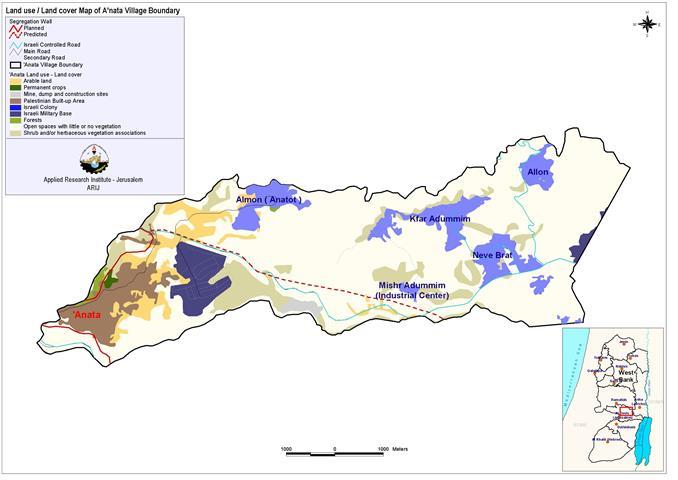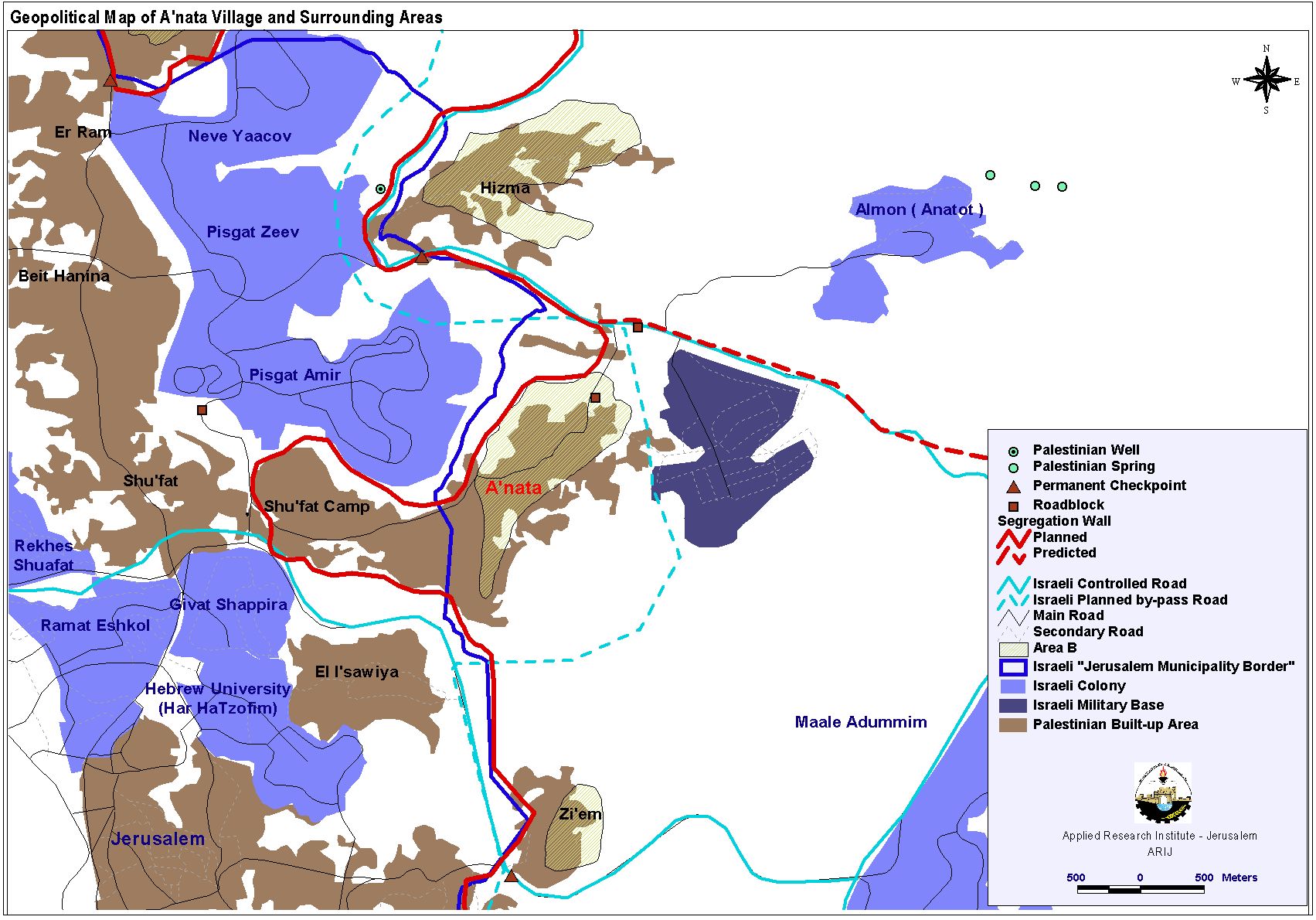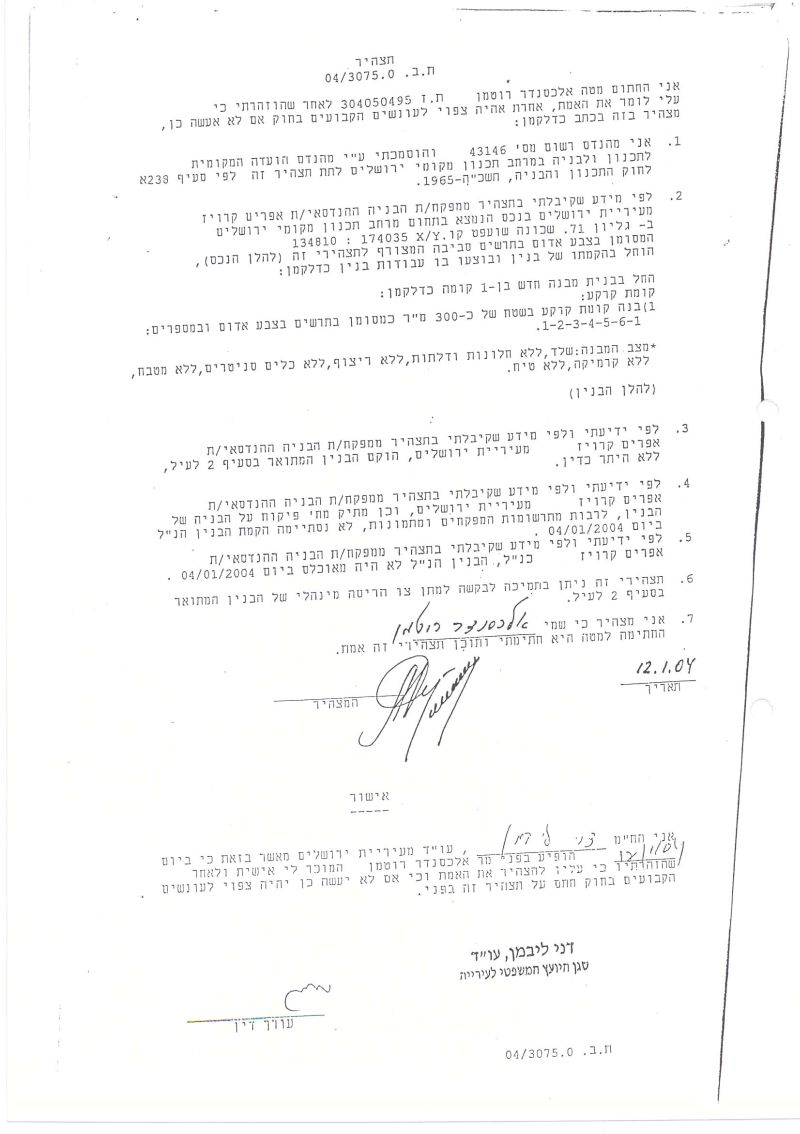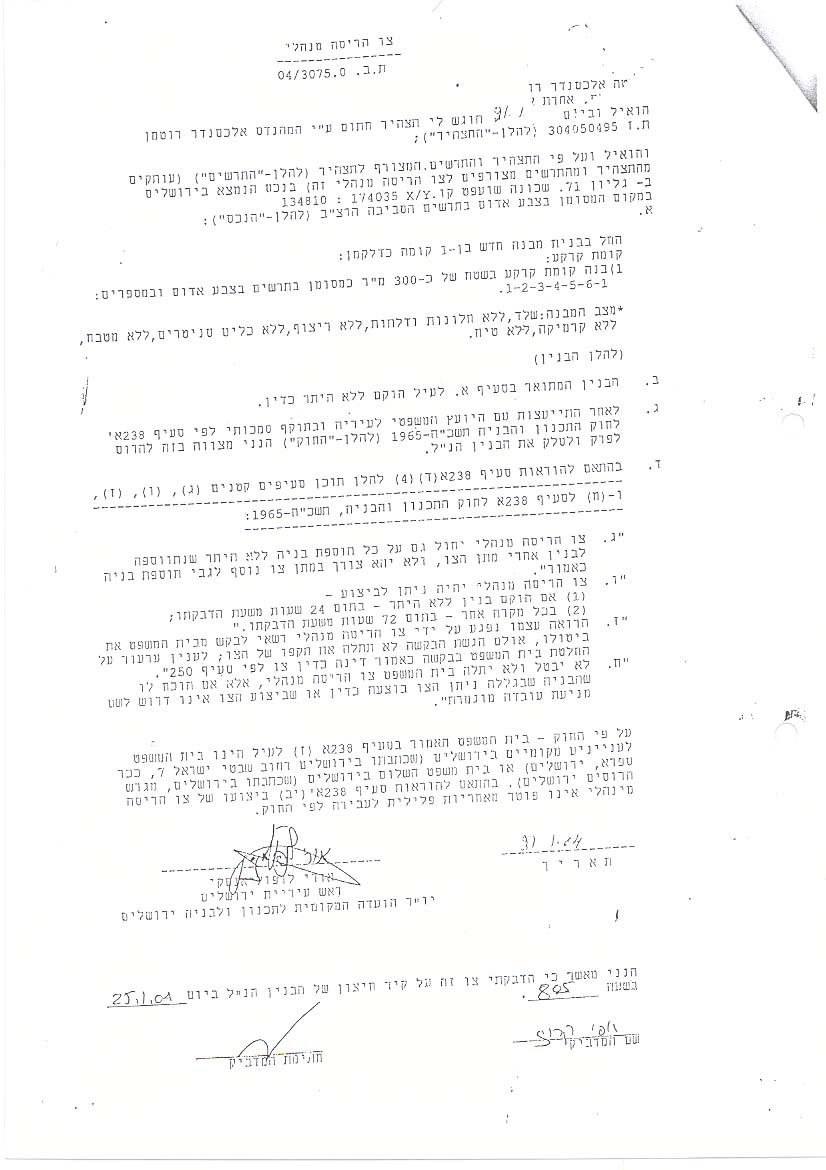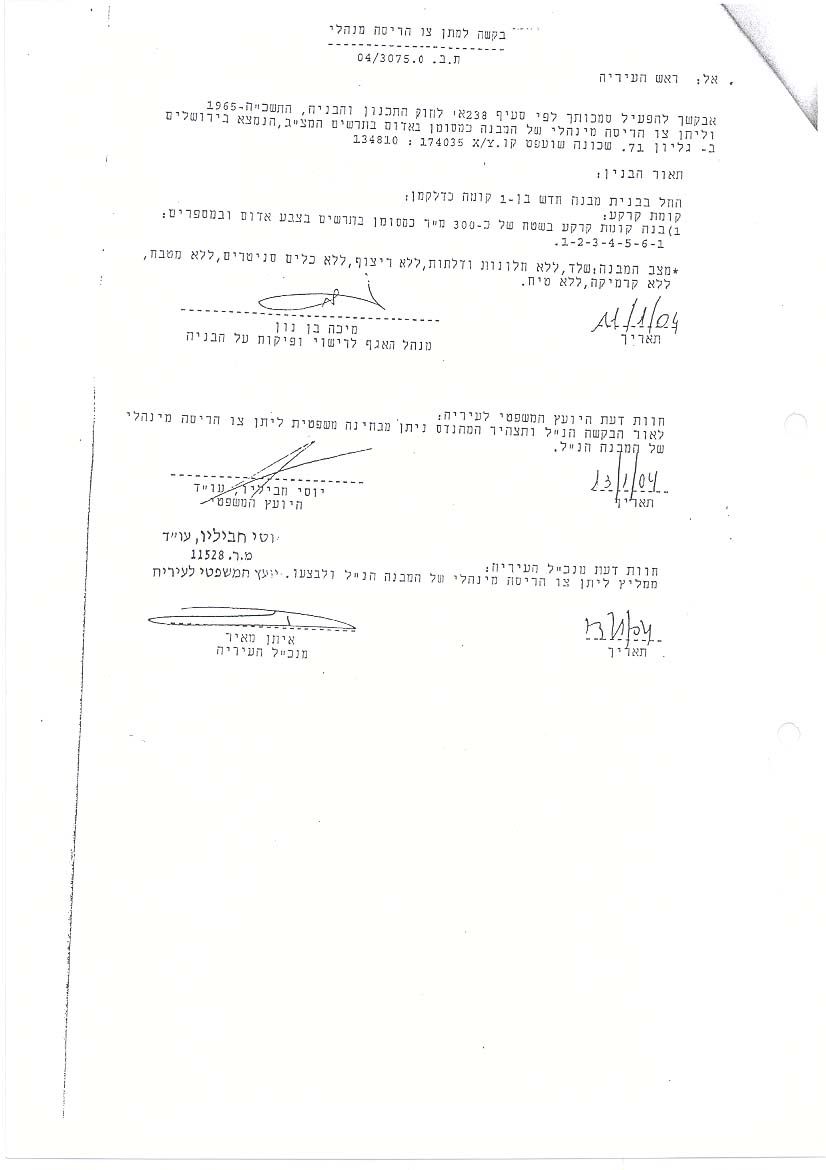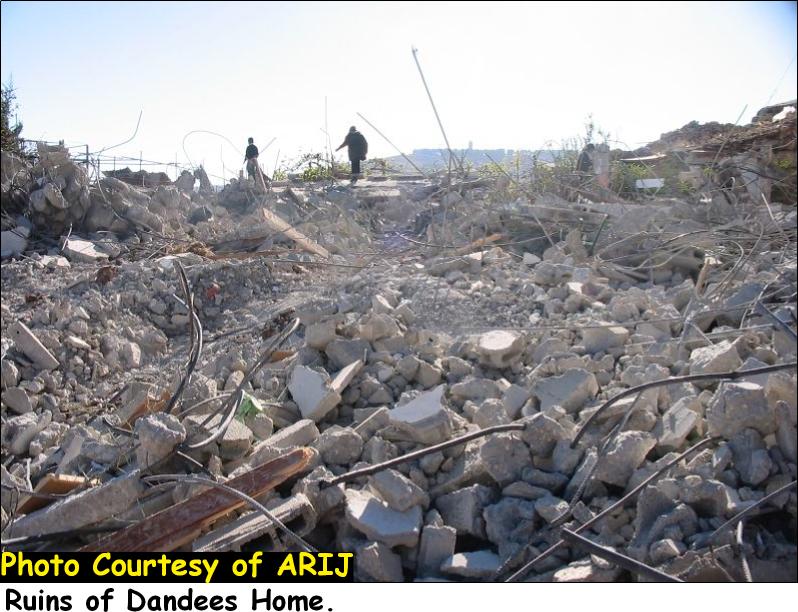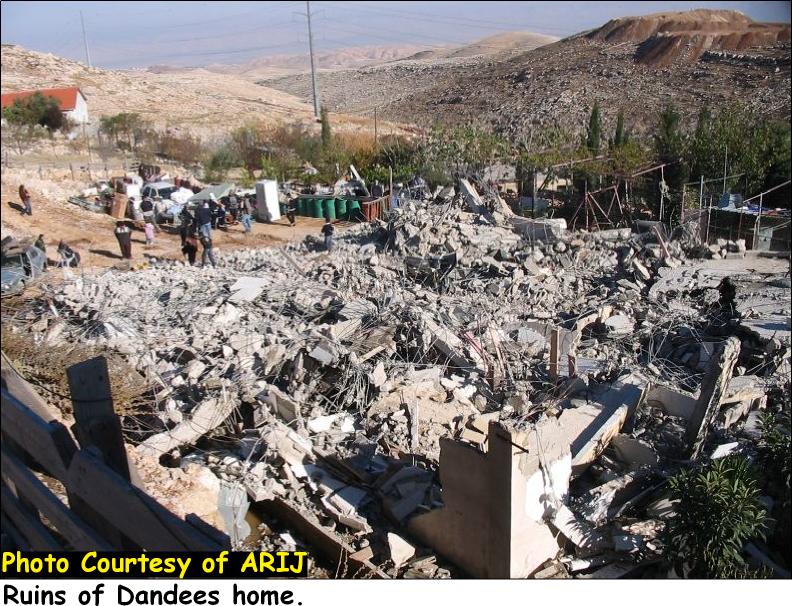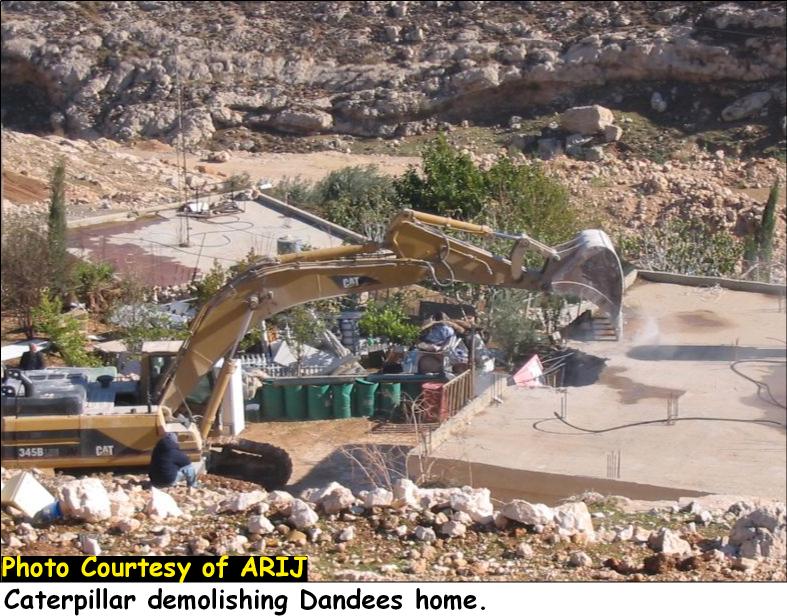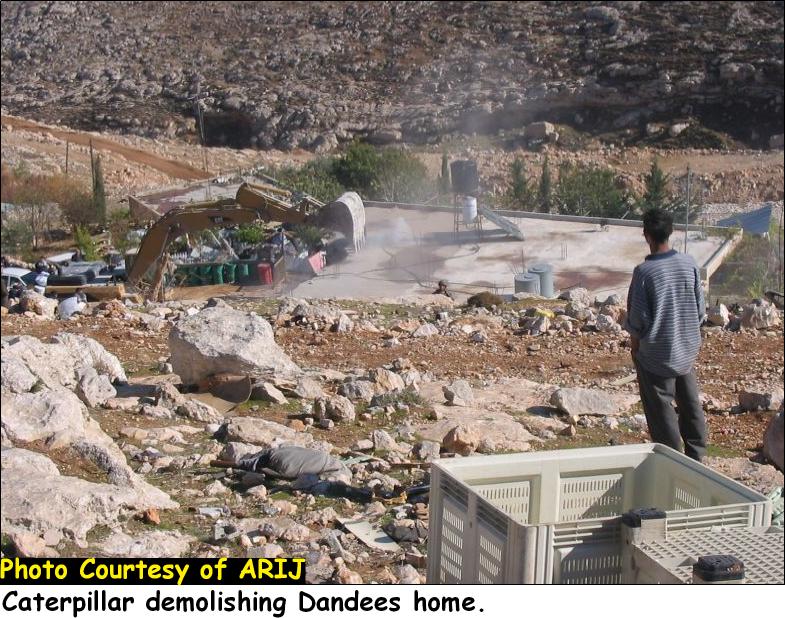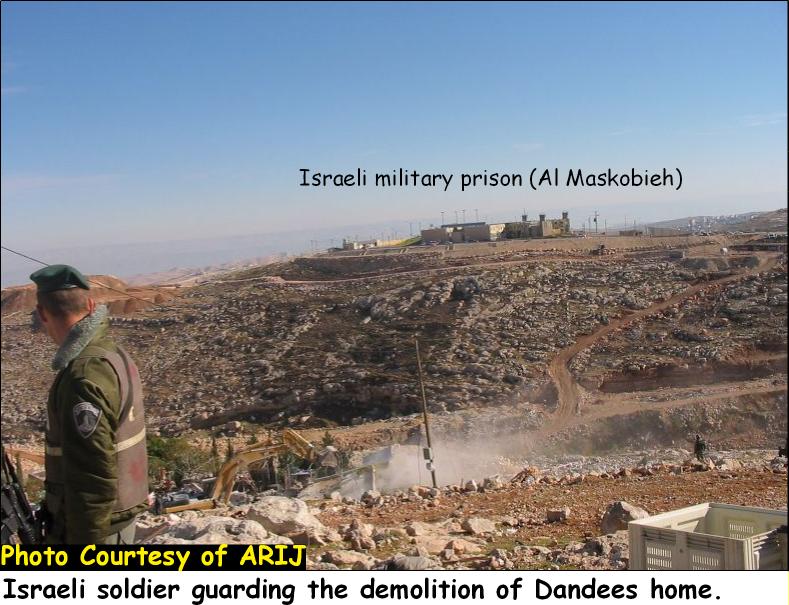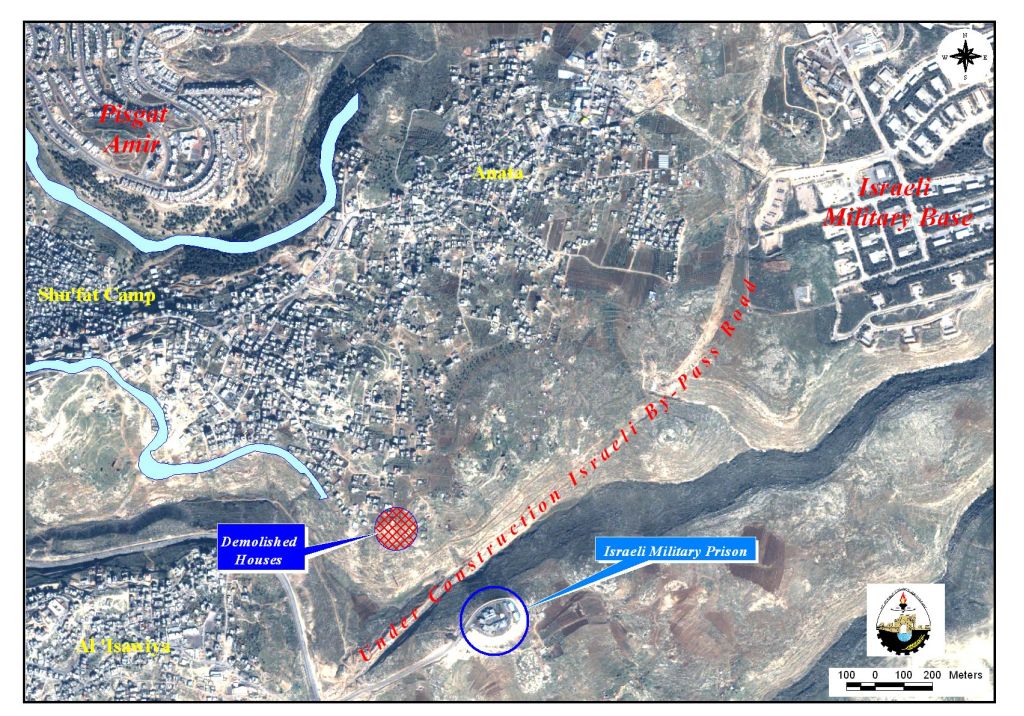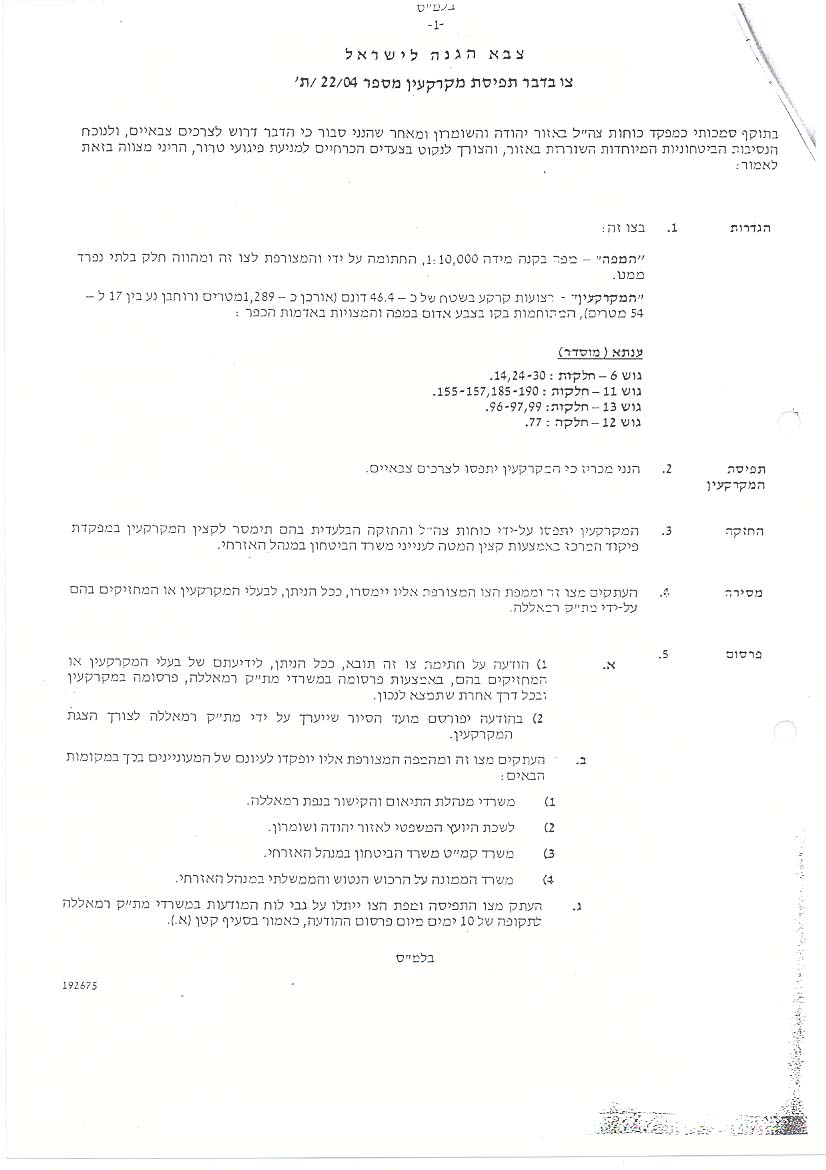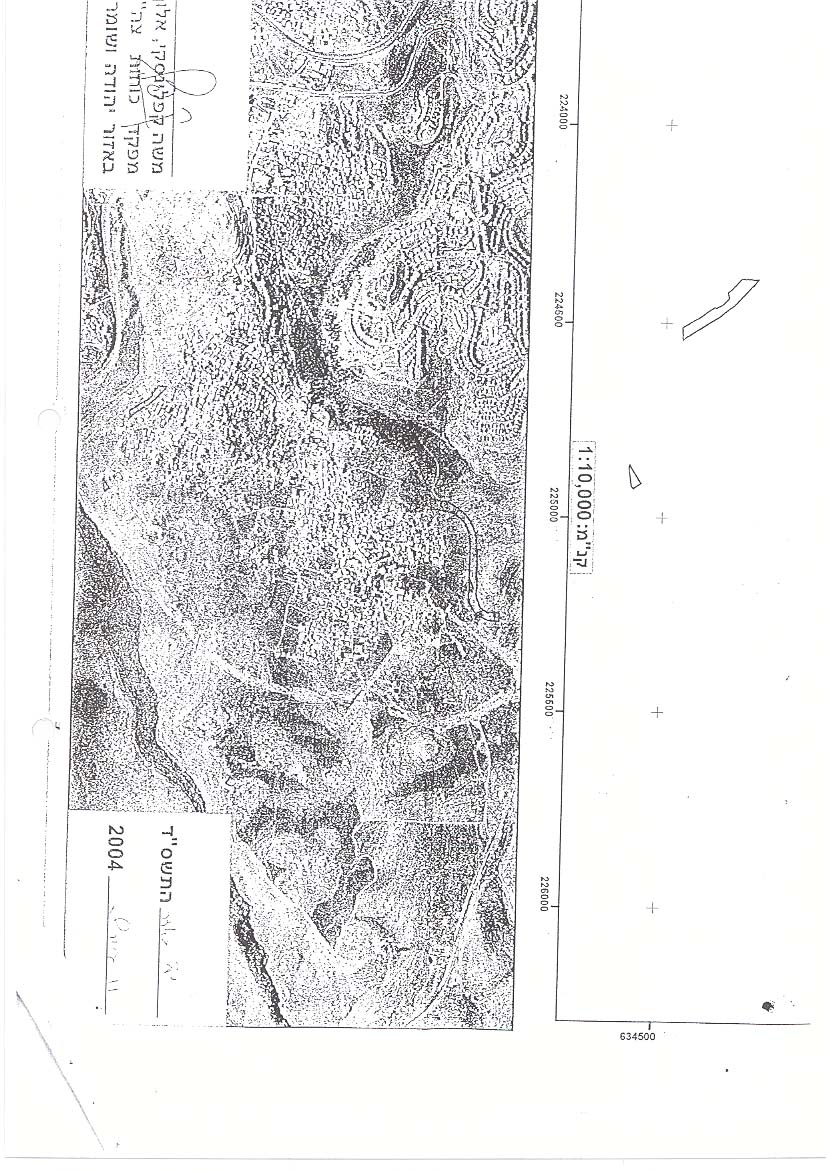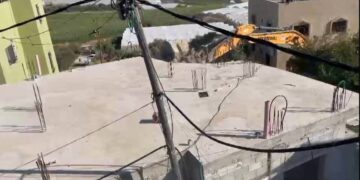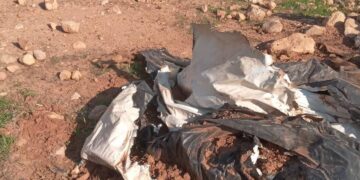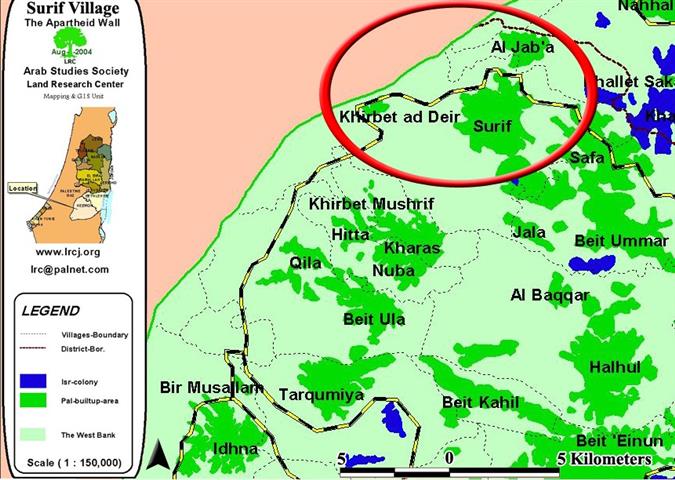On Monday, November 29 Israeli occupying forces demolished two Palestinian homes in the village of 'Anata. The homes were on the southern flank of the village near the planned path of the Israeli Segregation Wall. The home demolitions are part of a sustained campaign of destruction by Israeli occupying forces in 'Anata and throughout occupied East Jerusalem.
'Anata Village:
'Anata ' is a small Palestinian village located 4 kilometers northeast of Jerusalem. Its boundaries extend from Jericho in the east to Jerusalem in the west. According to the Palestinian Central Bureau of Statistics (PCBS), 9,076 people reside in the village. 'Anata's lands comprise 33,750 dunums. However, Israeli colonization in the village has reduced the lands available to the town's Palestinian residents. In fact, Israel has appropriated 12,450 dunumsof 'Anata's territory. The village is now left with a tiny enclave of 1,300 dunumsless than 4% of the original village (See Map One). ).
Map One: Land-Use in 'Anata
'Anata is under continual threat of more land being taken by the expansion of nearby illegal Israeli settlements, military establishments, by-pass roads and the Segregation Wall. In addition to two military establishments, there are four illegal Israeli settlements on 'Anata's land (see Chart One and Map One & Two): & ):
Chart One: Illegal Israeli Settlements in 'Anata
|
Name |
Block |
year |
area km2 |
Location |
|
Almon |
2_ 3 _ 4 |
1983 |
0.751 |
Northeast of A'nata village |
|
Kfar Adummin |
1 |
1979 |
0.785 |
Northeast of A'nata village |
|
Allon |
2 |
1991 |
0.347 |
Northeast of A'nata village |
|
Neveh Brat |
10 |
1988 |
0.51 |
East of A'nata village |
Map Two: 'Anata and Surroundings:
Home Demolitions in 'Anata and the Israelization of East Jerusalem
This week's home demolitions in 'Anata come within the context of an aggressive Israeli campaign aimed at the Israelization of Jerusalem. Following the 1967 war and the occupation of the West Bank, Israeli occupation authorities illegally expanded the municipal boundaries of Jerusalem to include the eastern part of the city and surrounding lands from the West Bank. The Jerusalem municipal area was expanded from 6.5 Km2 to 70.5 Km2 (growing to 10.8 times its original size). The expansion entailed the annexation of open spaces inside the West Bank. Utilizing this open space, Israel began to construct illegal settlements in strategic locations around Palestinian cities and villages. At the same time, Israeli occupation authorities began to enact numerous policies aimed at limiting the Palestinian population in East Jerusalem. Thus, Israel has sought to increase the Israeli Jewish population of East Jerusalem while simultaneously minimizing the Palestinian presence in the area. This demographic war has had severe affects on the Palestinian residents of East Jerusalem.
For example, Israeli imposed planning and zoning restrictions require Palestinians to apply for permits before building new structures or renovating an existing structure on their land in East Jerusalem. The permit process is long, tedious, expensive and disadvantages Palestinian applicants. Buildings constructed without permits are usually demolished by Israeli authorities. According to studies conducted by ARIJ, at least 631 Palestinian houses have been demolished in Jerusalem during the last ten years. Faced with the loss of their homes, many Palestinian families are forced out of the Jerusalem municipal boundaries.
A portion of 'Anata village has been included inside the illegally expanded Jerusalem municipal boundary. Residents of this area have born the brunt of the Israelization policy and many houses in 'Anata have been demolished by the Israel. Most homes have been destroyed under the pretext that the land-owners did not have ''building permits'' issued by Israeli occupation authorities in the Jerusalem municipal government. Israel justified this week's demolitions under the same pretexts
The Demolition of the Qaboah and Dandees Homes:
Two homes were demolished in 'Anata on Monday, 29 November 2004. Both homes were inside the illegally expanded municipal boundaries of Jerusalem. Demolition orders served to the residents on 26 November gave the families each three days to destroy the structures or they would be demolished by Israeli occupation authorities. The orders stated that the homes were to be demolished because they were built without building permits issued by Israeli occupation authorities in the Jerusalem municipal government. The current military orders were not available to ARIJ, but below is an example of a home demolition order served to one 'Anata resident:
On 29 November, Israeli occupying forces declared the area around the Qaboah and Dandees homes to be a 'closed military zone' and gave each family three hours to remove their belongings from the homes. Both homes were then destroyed by an industrial size pneumatic drill and a large backhoe. Both machines were produced by the Caterpillar corporation Details of the two cases follow:
-
The home of Jadoah Khalil Sleman Qaboah was demolished on the morning of 29 November 2004. The house was a 500 square meter, two story structure with four apartments. Qaboah is a legal resident of Jerusalem and holds legal title deeds to the land (Tabu: Documents of ownership) but all requests for building permits were denied by Israeli occupation authorities in the Jerusalem municipality. In a testimony given to ARIJ, Qaboah stated that he had worked 20 years to save the money needed to build his home. 23 members of the Qaboah family were left homeless as a result of the demolition. See Picture one & Picture Two
Pictures of Qaboah demolished home
-
The home of the Dandees family was demolished on the afternoon of 29 November 2004. The house was a 240 square meter, single story structure. The owner is a legal resident of Jerusalem and holds legal title deeds to the land (Tabu) but all requests for building permits were denied by Israeli occupation authorities in the Jerusalem municipality. In a testimony given to ARIJ, Mr. Dandees stated that he had worked 30 years to save the money needed to build his home. 13 members of the Dandees family were left homeless as a result of the demolition. See Picture Three & Picture Four
Pictures of Dandees demolished home
ARIJ fieldworkers observed the demolition of the Dandees home in 'Anata and filed this report: After demolishing the home of Jadoah Khalil Sleman Qaboah on the morning of 29 November 2004, Israeli occupation forces moved to the home of the Dandees family. Israeli Border Police surrounded the house and declared the area a 'closed military zone.' The Dandees family was given three hours to remove their belongings and pile them outside the house:
In the early afternoon, an industrial sized Caterpillar backhoe moved towards the home. As it neared the front wall, the owner of the home stepped in front of the machine causing it to stop momentarily. Border Police quickly grabbed the owner and forced him to the side. The backhoe then proceed to tear into the cement house, ripping apart the walls and rebar supports. The demolition lasted 5-10 minutes and a small wooden chicken shack was also destroyed. When it finished demolishing the house, the backhoe left the scene with the Israeli border police vehicles. After returning to the center of the village we received reports that Israeli occupation forces had also demolished some homes in a neighboring Bedouin encampment on the edge of 'Anata. See Picture five & Picture Six
Picture seven: An Israeli soldier guarding the demolition of Dandees Home
Home Demolitions in 'Anata and the Segregation Wall:
Demolition orders served to the Qaboah and Dandees families stated that the homes were demolished because they did not possess building permits for the structures. An analysis of Israeli planning in the area, however, suggests that the demolitions were also carried out in order to clear more territory for the construction of an illegal Israeli by-pass road cutting across 'Anata Village lands south of the built-up area and close to the Qaboah and Dandees homes. Residents also fear that a section of the Segregation Wall, or a secondary wall, will be built along the road.
The Dandees house was within 100 meters of the area demarcated for construction of the by-pass road and the Qaboah home was within 300 meters of the Wall's path. Construction of the road has begun along the bottom of the hill, and a new Israeli military prison (Al Maskobiah) sits atop the opposite hill. Israeli occupation authorities are currently expanding the prison over larger sections of the hilltop. The whole area is part 'Anata's historical territory and has been illegally appropriated by Israel (See Map Three).
Map Three: Demolished Homes and New Israeli By-pass Road
(Picture Eight: Pan of demolished Dandees home and military prison)
Residents of A'nata received military orders from Israeli occupation authorities in March 2004. The orders stated that portions of 'Anata's lands north and west of the village would be confiscated in order to build the Wall. On June 27, 2004, Israeli occupation bulldozers began land clearing operations on the confiscated lands. An example of the military orders follows:
(Israeli military orders in 'Anata village – Wall orders).
Construction of the Israeli Segregation Wall now threatens to turn the remainder of 'Anata's territory into a tiny ethnic ghetto. Israeli military orders show the path of the Wall cutting very close to 'Anata on two sides and, if the a section of the Wall is built along the new by-pass road, the village will be surrounded on all sides. As a result, 'Anata's residents fear that they will be left with only one entrance which will be controlled by Israeli soldiers. The Wall will also open up additional territories for the expansion of neighboring illegal Israeli settlements. In 'Anata, the path of the wall has been planned to include the illegal Israeli settlement of Pisgat Ze'ev, north of the village as well as the open space between 'Anata and the illegal settlement of Ma'ale Adummim to the south. Israel has zoned this area as 'E1' and plans to use it for the expansion of Ma'ale Adummim settlement (see Map Two).
Home Demolitions in International Law:
Israel's actions in East Jerusalem, including 'Anata Village, are in direct violation of numerous United Nations Security Council and General Assembly Resolutions. In particular, UN Security Council Resolution 242 (1967) calls for 'the withdrawal of all Israeli armed forces from the territories occupied' in the 1967 war; and UN Security Council Resolution 465 (1980) applies these principles more directly and forcefully to East Jerusalem, stating: 'all measures taken by Israel to change the physical character, demographic composition, institutional structure or status of the Palestinian and other Arab territories occupied since 1967, including Jerusalem, or any part thereof, have no legal validity.'
In addition, as an occupying power, Israel is bound by the application of international humanitarian law. The home demolition policy, however, violates the most basic tenets of the international legal regime.
The demolition of Palestinian homes and seizure of Palestinian lands to build Israeli settlements, by-pass roads and the Segregation Wall is explicitly outlawed by The Hague Conventions of 1907. Convention IV, Article 23 (G) clearly states that the occupying power is forbidden â??to destroy or seize the enemy's property, unless such destruction or seizure be imperatively demanded by the necessities of war.'
The Fourth Geneva Convention of 1949 also clearly prohibits the destruction of Palestinian homes. Article 53 of the Convention states: ''Any destruction by the Occupying power of real or personal property belonging individually or collectively to private persons, or to the State, or other public authorities or social or cooperative organizations is prohibited, except where such destruction is rendered absolutely necessary by military operations.'' Such policies target the civilian population of the Occupied Palestinian Territories and thus cannot be excused on the basis of military necessity.
In fact, Israel's home demolition policy is a fundamental violation of the Fourth Geneva Convention, Article 147 of which clearly prohibits, ''extensive destruction and appropriation of property, not justified by military necessity and carried out unlawfully and wantonly.'' According to the Convention, violations of Article 147, including the destruction of civilian infrastructure such as homes, constitute a 'grave breach' of the Convention and should be prosecuted as War Crimes.
Conclusion:
In addition to the two homes demolished in 'Anata Village on 29 November 2004, Israeli occupying forces also destroyed a third home in the neighboring village of Beit Hanina on Tuesday, November 30. According to a press release by the Israeli Coalition Against Home Demolitions (ICAHD), the home was owned by Muhammed Shabani and housed 11 people. The Shabani family held title to the land but were denied permits by the Israeli occupation authorities in East Jerusalem. International activists from ICAHD, B'tselem and the International Solidarity Movement attempted to stop the demolition but were dragged from the house by Israeli Border Police. The house had been targeted for demolition by Arieh King, a leading member of the National Unity Party in the Israeli Knesset. King reportedly lobbied the Israeli government to destroy the house in order to facilitate the expansion of the nearby illegal Israeli settlement of Pisgat Ze'ev
The demolition of Palestinian homes carried out by Israeli occupying forces in 'Anata village, on November 29, and Beit Hanina, on November 30, are violations of international law. Israel's home demolition policy is a grave breach of the Geneva Conventions of 1949 and the demolitions of Palestinian homes should be treated as War Crimes. In addition, since the demolitions come within the context of Israel's continued construction of the Segregation Wall in the Occupied Palestinian Territories (OPT), they stand as violation to the International Court of Justice's ruling on July, 9, 2004 which condemned the Wall and called for its dismantlement. The recent demolitions are also a further example of Israel's continued seizure of Palestinian land and the colonization of the OPT.
The construction of illegal Israeli settlements, by-pass roads and the Segregation Wall has contributed to the enactment of the Israelization policy in East Jerusalem. Like other Palestinian communities in the area, the Wall is turning 'Anata village into a tiny ethnic ghetto. The demolition of the Qaboah and Dandees homes contributes to the ghettoization of 'Anata by extending Israeli territorial authority over larger sections of the village's lands. The Segregation Wall threatens to seal this fate by surrounding 'Anata on three sides. As the case of 'Anata illustrates, Israel's home demolition policy is a barrier to any possible peace agreement in the Middle East and a direct attack upon the identity of Palestinians and their connection to their ancestral homeland.
Links;
- [1] For more on 'Anata Village see the ARIJ profile at This Link.
- [2] 3,375 km.2 or 8,437 acres (1 dunum equals 1000 meters2 or 1/4 acre). Source: 'Anata Village Council, 2004.
- [3] 1,245 km.2 or 3,112 acres.
- [4] 130 km.2 or 325acres.
- [5] 'Anata Village Council, 2004.
- [7] For more information on Caterpillar and the worldwide campaign to stop caterpillar sales to Israel see www.catdestroyshomes.org.
- [8] The Israeli Coalition Against Home Demolitions (www.icahd.org).
Prepared by:
The Applied Research Institute – Jerusalem


